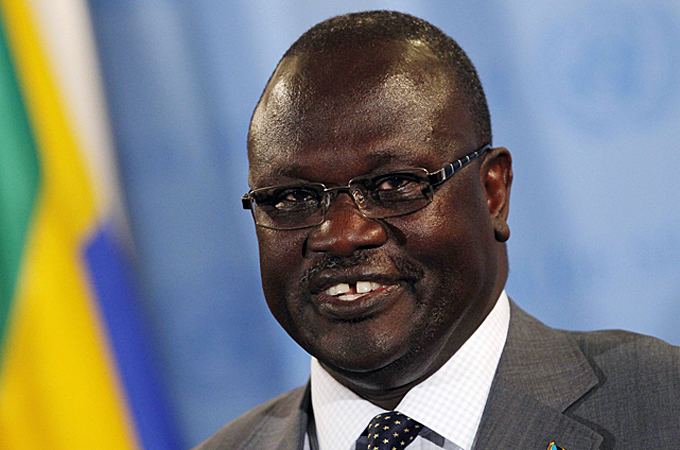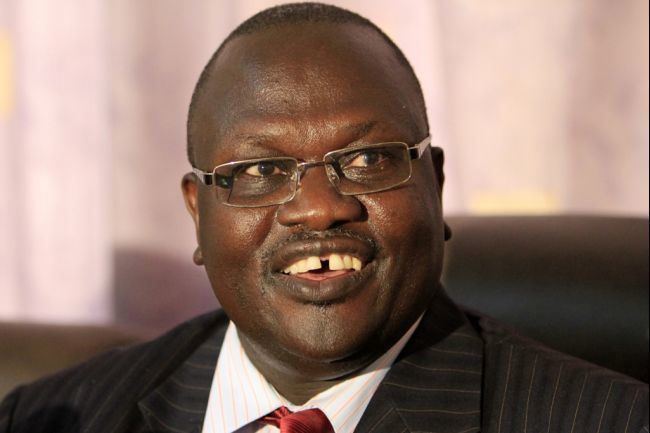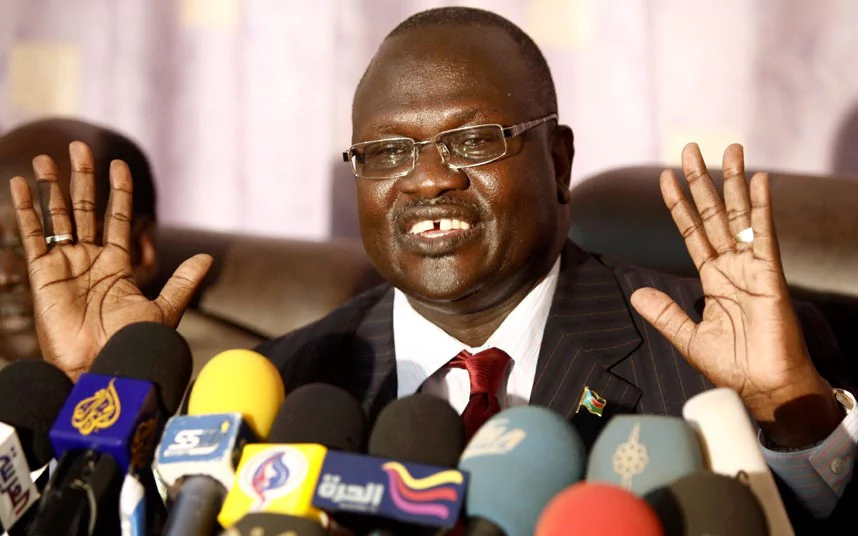Preceded by position established Religion Presbyterian Name Riek Machar | Nationality South Sudanese Children 4 | |
 | ||
Full Name Riek Machar Teny Dhurgon Party Sudan People's Liberation Army Office Vice President of South Sudan since 2011 Similar People | ||
Uhuru kenyatta meets south sudan s former vice president riek machar
Riek Machar Teny Dhurgon (born 1953) is a South Sudanese politician who served as the inaugural Vice President of South Sudan, from its independence in 2011 until his dismissal in 2013. Between April and July 2016 Machar served as the First Vice President of South Sudan. He now leads the rebel faction opposing Salva Kiir known as SPLM-IO.
Contents
- Uhuru kenyatta meets south sudan s former vice president riek machar
- Dr riek machar first vice president of south sudan visited in minnesota
- Early career
- Return to SPLM
- South Sudan politics
- Controversy
- Return to vice presidency and second sacking
- Literary work
- References

Machar obtained a PhD in strategic planning in 1984 and then joined the rebel Sudan People's Liberation Movement/Army (SPLM/A) during the Second Sudanese Civil War (1983–2005). Riek fell out with the SPLM/A leader John Garang in 1991 and formed a splinter group, the SPLM/A-Nasir. In 1997 Riek made a treaty with the Government of Sudan and became head of the government-backed South Sudan Defense Force (SSDF). In 2000 he left the SSDF and formed a new militia, the Sudan People's Defense Forces/Democratic Front (SPDF), and in 2002 rejoined the SPLA as a senior commander. After the death of John Garang in July 2005, Riek Machar became vice-president of the autonomous Southern Sudan. He became vice-president of South Sudan on 9 July 2011 when the country became independent, but was dismissed from office by President Salva Kiir Mayardit on 23 July 2016.

Dr riek machar first vice president of south sudan visited in minnesota
Early career

Riek Machar Teny Dhurgon was born in Leer, Unity State in 1953, the 26th son of the chief of Ayod and Leer. He was brought up as a member of the Presbyterian church. Machar belongs to the Dok section of the Nuer people. He trained as an engineer at Khartoum University, and obtained a PhD in Philosophy and strategic planning from the University of Bradford in 1984.

Machar has been called a tuut dhoali/Doth in English, which may be translated "adult boy", meaning uninitiated and literate. He has tried to transcend tribal divisions, and at one time attempted to ban initiation marks. However, in his struggle with John Garang he exploited ethnic rivalries between the Nuer and Dinka people. Machar married Emma McCune, a British aid worker. She died in a car accident in Nairobi in 1993 at the age of 29, while pregnant. Machar's second wife, Angelina Teny, is one of the leading women politicians in South Sudan. She was state minister of Energy and Mining in the transitional government (2005–2010).

Machar was a rebel leader with the Sudan People's Liberation Army/Movement (SPLM/A) headed by John Garang from 1984 until he fell out with Garang in 1991. As Zonal Commander of Western Upper Nile, in 1986 he entered into an agreement with Baggara chiefs. Machar led forces that attacked and overran Melut in 1989. That year he was able to visit his family, which was based in Britain, for the first time since the civil war started. In 1990 Machar was based at Leer. Later he was appointed SPLA Regional Commander for a region that extended from the Ethiopian border in the east to Renk in the north and to Ayod and Waat in the south.
Machar disagreed with the SPLA leader John Garang over objectives. Where John Garang at first wanted a secular and democratic but united Sudan in which the southerners would have full representation, Machar wanted a fully independent South Sudan. In August 1991 Riek Machar, Lam Akol and Gordon Kong announced that John Garang had been ejected from the SPLM. Kong Chuol is from the Eastern Jikany Nuer and Lam Akol is from the Shilluk people. The breakaway faction, based in Nasir until 1995 and then in Waat and Ayod, was called the SPLM/A-Nasir faction from 1991 to 1993. As part of SPLA-Nasir, he was involved in the Bor massacre, where 2000 mostly civilians were killed in Bor in 1991 while tens of thousands died in the following years from the resulting famine. The Bul Nuer Anyanya-2 militia at Mayom under Paulino Matip and the Lou Nuer Anyanya-2 militia at Doleib Hill under Yohannes Yual declared for Riek.
Kerubino Kuanyin and Faustino Atem Gualdit, Dinkas from Bahr el-Ghazal, had been among the founders of the SPLM but had fallen out with John Garang and had been jailed. They escaped and joined Machar in 1993, with their forces making an important addition to the formerly Nuer-dominated SPLA-Nasir. Kerubino became deputy Commander in Chief. After this addition by forces from other ethnic groups, Riek's movement and force was called the SPLA-United from 1993 to 1994.
In September 1993, President Daniel Arap Moi of Kenya held separate talks with Garang and Riek Machar. In October 1993 the US Congress hosted a meeting between Garang and Machar. The two seemed to agree about various subjects related to a cease fire and reconciliation between the two factions, self-determination and opposition to the Khartoum regime, but Machar disputed Garang's authority and refused to sign a joint declaration. Machar dismissed Lam Akol from the SPLA-United in February 1994. Lam Akol returned to Kodok in the government-held region of Upper Nile state.
From 1994 to 1997 Machar's movement was known as the South Sudan Independence Movement/Army (SSIM/A). Although seeking independence for South Sudan, the group received covert support from the Government of Sudan as it fought the SPLA between 1991 and 1999 in attacks that became increasingly violent and ethnically motivated. Early in 1995 hostilities between the SSIM and SPLA, which had taken several thousands of civilian lives, were temporarily suspended. Machar dismissed Kerubino Kuanyin and Commander William Nyuon Bany from the SSIM on the basis that they had signed military and political agreements with the government of Sudan late in the previous year, and that they had attempted to form a government-supported faction in the SSIM.
During the 1990s Machar skillfully developed support among the eastern Nuer, the Jikany and the Lou, taking advantage of SPLA unpopularity with the Jikany and drawing on prophetic tradition to make his case. In 1996 Machar signed a Political Charter and in 1997 the Khartoum Peace Agreement with the government. Under this agreement he was assistant to Omar el-Bashir, President of Sudan, and President of the Southern States Coordinating Council. He was also made commander in chief of the South Sudan Defense Force (SSDF), which included most of the ex-rebels who had signed the Khartoum agreement.
Return to SPLM
There was growing tension between Riek Machar and Paulino Matip's South Sudan Unity Movement (SSUM), which became engaged in forcibly removing civilians from the Block 5A oil concession area, and assisting in clearances from other oil blocks. In 1998–1999, Matip's fighters and government troops clashed several times with Machar's SSDF forces in a struggle for control of the Unity state oilfields. Matip's fighters forced Tito Biel, a high-ranking SSDF commander, to evacuate Leer early in 1999. Tito Biel later went over to the SPLA.
Riek Machar's failure to prevent the government from forcibly displacing civilians from the oil-producing areas of Unity State turned the Nuer against his leadership. Machar's SSDF began to receive ammunition from the SPLA as of June 1999. In 2000 at a meeting of leaders in Koch he finally resigned from the government of Sudan and created a fresh militia named the Sudan People's Defense Forces/Democratic Front (SPDF). At risk in his own homeland of the Dok Nuer, Riek moved his base of operations to the eastern Jikany area. In January 2002 he signed an agreement with John Garang to merge the SPDF into the SPLA, and was given command of the Dok Nuer within the SPLA.
The civil war ended in January 2005. In August Machar became Vice President of the Government of Southern Sudan and SPLM Co-Chair of the Joint Executive Political Committee. When South Sudan became independent, in July 2011 he was appointed first Vice President of the new republic. On 15 July 2011 Machar represented South Sudan at the ceremony when his country's flag was raised outside United Nations headquarters in New York.
South Sudan politics
Following the independence of South Sudan, Machar was the vice president of the country. By February 2013 Machar publicly stated his intentions to challenge President Kiir. In July 2013, he, and the entire cabinet, was dismissed from office. Machar said that Kiir's move was a step towards dictatorship. These events in turn led to the South Sudanese Civil War.
In 2012, he publicly apologized for his part in the Bor massacre as he prepared to pave way for taking the helm of SPLM.
Controversy
Machar already known for his high degree of political and leadership ambition has revived links with the Government of Sudan in Khartoum for the purpose of receiving adequate resource and political support to achieve his political objectives. British monitors have confirmed the delivery of several payloads of heavy military hardware to Machar's loyalists. The presence of specific military equipment (Norinco weaponry) is attributed almost exclusively to Khartoum's support lines. Approximately 40,000 automatic rifles, 5,000 RPG units and some 5,000 heavy machine guns of various designations alongside truckloads of ammunition have been logged at border crossings and along the northern perimeter of South Sudan.
Return to vice-presidency and second sacking
In late August 2015, a peace agreement was signed between the government and Machar's rebels. The agreement would make Riek Machar the vice-president again. In April 2016, as part of the peace deal, Machar returned to Juba and was sworn in as vice-president. Machar fled the capital after renewed fighting between the Kiir loyalists and his own loyalists Juba in July 2016. After a 48-hour ultimatum given by the president to him for returning to Juba to progress with the peace agreement talks passed, the SPLA-IO in Juba appointed lead negotiator Taban Deng Gai to replace Machar and the government accepted him as acting vice-president. Machar said any talks would be illegal because he had fired Gai.
